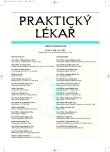Neurological complications of Q fever
Neurologické komplikácie Q horúčky
Q horúčka je zoonóza vyvolaná intracelulárnym parazitom Coxiella burnetii, ktorého rezervoárom sú hlavne hovädzí dobytok, ovce a kozy. Človek sa najčastejšie infikuje vdýchnutím kontaminovaného aerosolu obsahujúceho častice patogéna. Ochorenie prebieha ako chrípke podobný horúčkovitý stav, pneumónia alebo hepatitída. Neurologické príznaky Q horúčky sú pomerne zriedkavé a nešpecifické. Najčastejšie boli opísané bolesť hlavy, meningitída, meningoencefalitída a i.
Kľúčové slová:
Q horúčka, Coxiella burnetii, meningitída, meningoencefalitída, myelitída.
Authors:
E. Dorko; V. Krajcárová; Z. Kalinová
Authors‘ workplace:
Lekárska fakulta UPJ·, Košice, Slovenská republika
; Prednostka: prof. MVDr. Lýdia Čisláková, CSc.
; Ústav epidemiológie
Published in:
Prakt. Lék. 2007; 87(4): 228-230
Category:
Of different specialties
Overview
Q fever is a zoonotic disease caused by the obligate intracellular parasite Coxiella burnetii, the most common reservoirs for Coxiella burnetii are cattle, sheep and goats. Human infection occurs following inhalation of contaminated aerosols. Infections can be manifested as a flu-like disease, pneumonia or hepatitis. Neurological symptoms of Q fever are rare and non-specific. Headaches, meningitis, meningoencephalitis have been the most frequently described.
Key words:
Q fever, Coxiella burnetii, meningitis, meningoencephalitis, myelitis.
Labels
General practitioner for children and adolescents General practitioner for adultsArticle was published in
General Practitioner

2007 Issue 4
- Memantine in Dementia Therapy – Current Findings and Possible Future Applications
- Memantine Eases Daily Life for Patients and Caregivers
- What Effect Can Be Expected from Limosilactobacillus reuteri in Mucositis and Peri-Implantitis?
- Metamizole at a Glance and in Practice – Effective Non-Opioid Analgesic for All Ages
Most read in this issue
- Todays trends of diagnostics and treatment of scaphoid bone fractures
- Extensive trombosis of thoracic aorta – an unusual source of acute peripheral arterial embolism.
- Epileptic fit as a syncope equivalent in severe aortic stenosis.
- Smoking and skin
